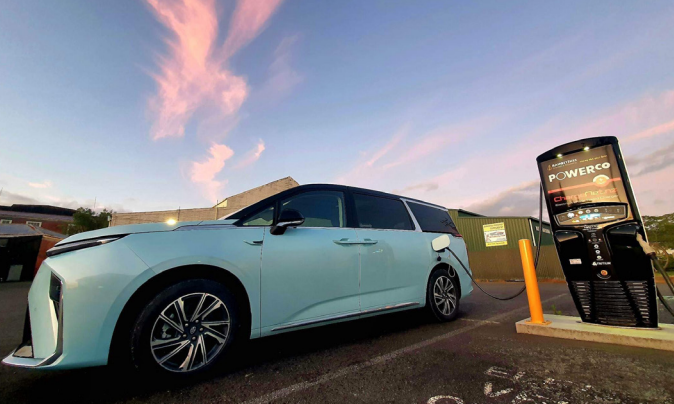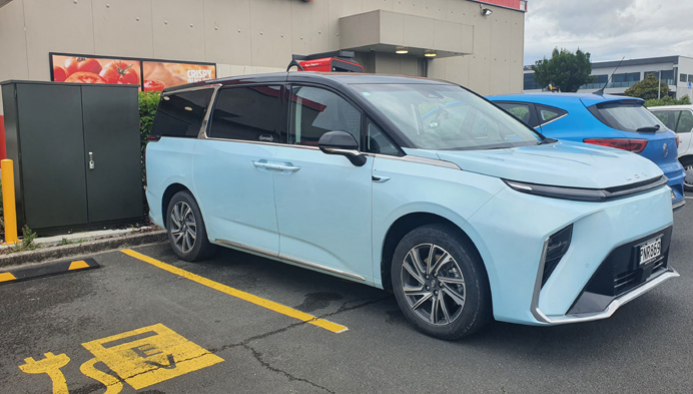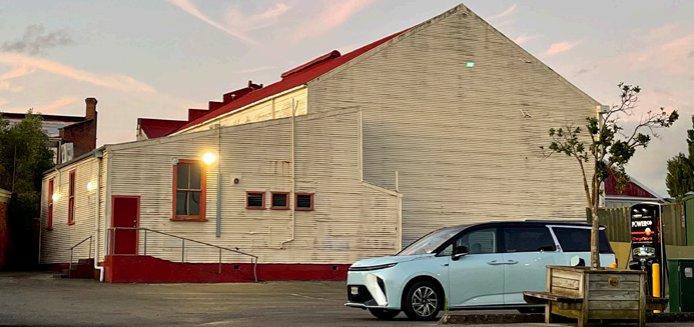
Managing editor Richard Edwards explains the key tips for an easier long-distance road trip in an electric vehicle by driving an LDV Mifa 9 from Northland to Canterbury.
The LDV Mifa 9 is an electric people mover with seven comfortable seats, some with a massage function, a 90-kWh battery and range of 350 to 400km.
Our test run took two days and two nights to drive from Mangawhai in Northland, to Christchurch in Canterbury.
The Mifa 9 can carry up to 700kg but for this trip, we were running lighter with around 350kg of luggage and people on board. (Subhead) Leave full, and prepare In the haste to get ready for a long-distance road trip many people make the simple mistake of not plugging in their EV in enough time to make sure the traction battery is at 100% capacity.
Always leave with a full charge on-board. This is so important. With DC charging it takes time to get the top 20% of battery back, so you leave on the back foot. There is additional preparation that will make your trip easier.
Make sure you have your charging fobs and apps – ChargeNet, Open Loop, Z Energy, BP.
Plugshare is a must for checking-in at stops. A Better Route Planner and PowerTrip are handy, but more for those who are aiming to stretch their range, which isn’t something I’d attempt with the variability of summer conditions.
Check your tyre pressures; it can help efficiency. Also clean your windscreen and top off your washer bottle. Public Charging stations don’t have buckets, brushes, and taps! Last, think about packing. You can’t beat physics, and an overladen car will use more energy than a lightly loaded one. Same with the bikes on the back of the car or kayaks on the roof.
Will you use them? If not, leave them behind. (Subhead) Charge early, charge often Out of Mangawhai, the Mifa was pointed south and headed for Auckland, in some rather average conditions.
A quick stop was made in Mt Roskill to collect our co-driver, before a stop at the Bombay ChargeNet hyper-charger. At this point we were well under half-way through the battery, with over 200km of range available. So why charge here? Safety and efficiency.
We could’ve pushed on and charged further down the road, but most charger options before Taupo are single 50kW units where the chance of queuing on a busy day is high.
Heading for multiple units reduces this and being a hyper-charger we were in and out of there faster, at just over 20 minutes to bring us back up to 360km of range. If you’re under 70% battery, don’t drive past an empty charger.

It will give you so many options later. The Mifa surprised with a peak charging speed this time of nearly 100kW, well about the 90kW speed marketed. But more was to come. (Subhead) Slow down (a little) Not long after Bombay is the Waikato expressway, a piece of road with a 110km/h speed limit, and a great spot to test my next tip.
We ran the Mifa at 90km/h and averaged 17kWh per 100km to maintain speed. Up the speed to 100km/h and you burn 21kWh per 100km, while moving to 110km upped the burn rate to 26kWh per 100km.
On a 50kW charger that’s probably an additional 10 minutes of charge and up to $7 in additional charge cost per 100km of travel. Slow down, reduce charging time, reduce cost! (Subhead) Help your fellow EV drivers We rolled into Taupo with just over 30% battery remaining.
Sure, we could have carried on to Turangi or even Waiouru, but with either single or 50kWh units coming ahead, heading to Taupo with its wide array of charging options was the smart move.
We plugged in for what proved to be a 20-minute top-up, with the Mifa again out-performing specification, peaking at 130kW, before settling on a solid period of 115kW. Here we stumbled across two fellow EV users in trouble.
One we couldn’t assist but the other we could. If you see someone struggling, offer to help. The quicker people can get on and off the charger, the better for everyone. (Subhead) Give yourself options The Mifa flew (at legal speeds) over the central plateau, with a quick stop at Waiouru to catch-up with some EV friends at the two units outside the Army Museum.
They confirmed the comfort of the car’s second row. It was lucky we had plenty of range as two chargers were in use when we arrived, with another car waiting.
Our target was Bulls, and with an energy recouping downhill run, we arrived with around 120km of range left. Having range left at your intended charging spot is key. This gives you options, one we almost needed as on arrival as a new MG ZS EV was charging.
We had the ability from there to get to at least three further 50kW charging stations, two of them with multiple units. This reduces the risk of having to queue. As it turns out while we were preparing to leave the owner of the MG turned up, and we were able to charge for 25 minutes for the run into Wellington.
This was both an overcharge – we were probably too cautious and needed only 15 minutes’ charge to make the trip, and the last DC charge we’d need to get to Christchurch.
Why? (Subhead) Charge while you sleep! This is one of my top tips for EV road trips: work on the basis of charging while you sleep. And if you’re concerned about how far you can get safely in a day, take an extra night and reduce your DC charging needs. In this case, we were staying in Wellington, at the Novotel, where we rolled in around 10.30pm, with a healthy amount still on the Guess-o-meter.
This inner-city hotel has a type 2 7kW unit and a Tesla destination charger, both free for guests, though the hotel recommends booking them. Multiple accommodation websites now have a search by EV charger option, but my tip is to call the hotel first and check the charging that it has suits your car and can be booked.
Staying at campgrounds? A higher amperage ‘blue commando’ EVSE or adaptor could be a good back-up. In some cases, charging where you stay can be of economic benefit.

We took on around 65kWh on the charger, which could cost around $55 at a DC unit. Take that off the hotel bill and our stay, with breakfast, came down to just $152. If you’re staying with family, take your charging cable with you. Sure, you won’t get a full charge every night, but at around 24kWh per 24-hour period, it sure helps.
Of course, ask in advance and offer to compensate them. I recommend a rate of around 30 cents a kW/per hour, as a token. It’s a great chance to educate as well. (Subhead) Relax, enjoy yourself The next day it was on to the ferry for the trip to Picton.
I highly recommend charging before you get on the ferry heading in either direction so you can get underway without hassle.
Particularly heading south charging is limited. Don’t plan on charging if you can get away with it. The Mifa had plenty of charge on board, so we cruised all the way down to Kaikoura for our second night away, though we could have made it to Christchurch with a ‘splash-and-dash’ here or further along the road. Instead we got to try one of the new EV Power units installed at the new Sudima Kaikoura. Again, the free charging mitigated the cost. The final morning involved a relaxing day’s cruising along the Kaikoura coast, before heading inland and south to the Mifa’s new home at LDV Christchurch.
Splitting the trip up made for a relaxing experience, with no need to charge on route at all. To reiterate my first tip: leave full. You won’t regret it!








